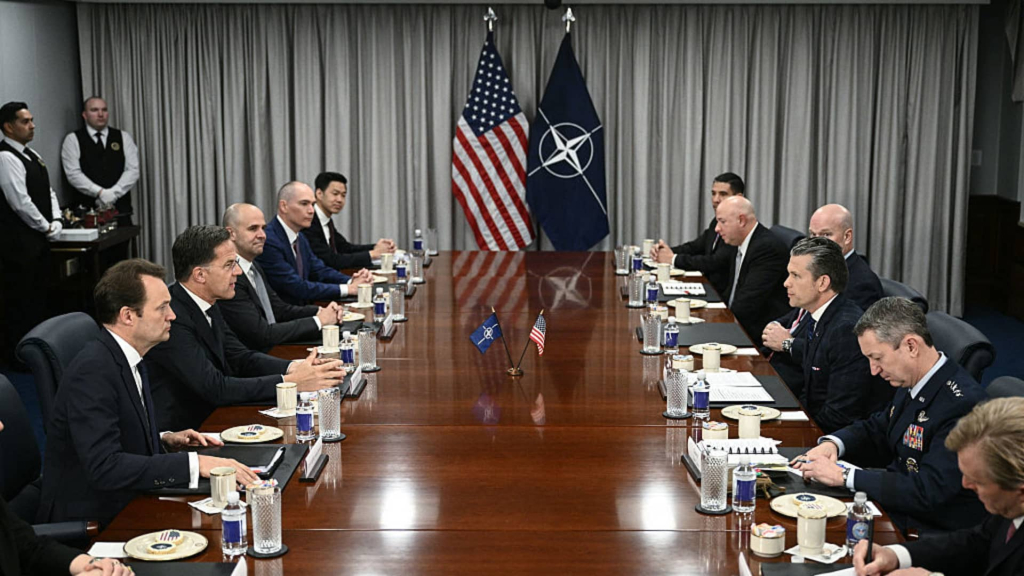This week’s NATO summit is anticipated to be a pivotal event, especially as the United States urges its allies to raise their defense expenditures to a significant 5% of their gross domestic product (GDP).
This proposed 5% figure is divided into 3.5% earmarked for “pure” defense initiatives and an additional 1.5% aimed at enhancing security-focused infrastructure, which includes capabilities related to cyber warfare and intelligence operations.
While several member nations express their intent to meet this ambitious goal, a substantial number still fail to reach the previously established 2% benchmark from over a decade ago. These nations may voice their commitments to increase spending, but whether these declarations translate into actual financial backing remains a critical concern.
As talks progress, decisive action will be the focal point for the U.S. and President Donald Trump, attending his first NATO summit since 2019.
Kurt Volker, former U.S. ambassador to NATO and a distinguished fellow at the Center for European Policy Analysis (CEPA), stressed that the U.S. expects member states to confirm they are serious about meeting the 5% target. “The U.S. is looking for everybody to say, ‘Yeah, we mean it. We have a plan. 5% is real. We’re going to get there’,” Volker stated on Wednesday.
He highlighted a potential discrepancy in messaging from some European allies, who, while claiming support for the 5% target, might suggest that the actual commitment is closer to the combined 3.5% for defense and 1.5% for various sectors. This could lead to an immediate dilution of defense spending commitments, Volker warned, which could prompt friction with U.S. expectations.
High stakes, low expectations
As allies convene in The Hague, Netherlands, on June 24-25, the context of ongoing conflicts in Ukraine and the Middle East underscores the urgent need for a cohesive defense strategy. Analysts assert that this year’s gathering may prove to be one of the most significant in NATO’s 77-year existence, especially as U.S. spending goals amplify the stakes before the meeting.
U.S. Defense Secretary Pete Hegseth has been vocal in asserting that 5% of GDP “will happen,” a sentiment echoed by NATO Secretary General Mark Rutte, who has actively advocated this point among member states.
The issue of defense spending has long been contentious among NATO members and has been a persistent point of frustration for Trump, who advocated for allies to increase their spending from 2% to 4% of GDP as early as 2018. Nonetheless, defense budgets among NATO members have risen significantly since his previous tenure.
Read more
Previously, only six member nations managed to meet the 2% guideline, including the U.S., at a time when Trump expressed considerable irritation with NATO. However, significant changes have occurred; as of 2024, 23 members are reported to meet this threshold, according to NATO statistics.
While countries like Poland, Estonia, the U.S., Latvia, and Greece have exceeded the target, larger economies such as Canada, Spain, and Italy remain below it. No NATO member has so far achieved the 5% objective, and some countries are expected to delay reaching this target.
The U.K., Poland, and Germany have all signaled their intention to raise defense spending, but specific timelines remain uncertain. Reports indicate the U.K. may seek to postpone the spending increase for three years. Meanwhile, Spain and Italy may resist the 5% target, focusing instead on achieving the 2% goal by 2025, with Canada also lagging by spending only 1.3% of GDP on defense, which is lower than Italy, Portugal, or Montenegro.
Meeting the 5% defense spending requirement is a target that remains uncertain, as Jason Israel, a senior fellow for the Defense Technology Initiative at CEPA, noted. “Every single country … is trying to figure out how they’re going to thread that needle of being able to make the commitment, but also make the accounting work when every single nation has to make trade-offs against what is generally unpopular, massive increases in defense spending,” he explained, emphasizing the disconnect between commitments and actual military capabilities.
Europe must commit
European defense and aerospace firms are closely monitoring NATO’s discussions regarding spending but find themselves at a crossroads between commitments made and tangible government contracts. Leaders from companies like Leonardo, Embraer, and Saab emphasized the necessity for Europe to adopt a coordinated and robust approach to defense spending to allow firms like theirs to enhance production capacity and manufacturing capabilities.
Micael Johansson, CEO of Saab, articulated the importance of understanding capability targets, noting that if Europe aims for a 3.5% target for pure defense spending, it will necessitate more spending to meet capacity. “We can do more, and I think we need to come together in Europe to create more scale, also in what we do to align demand,” he said, underlining the need for collaborative efforts in the defense sector.
Roberto Cingolani, CEO of Leonardo, echoed this sentiment, asserting that significant effort is required to ensure the defense sector can meet future demands. “Leonardo has a capacity boost program at the moment because we are quite aware of the fact that we have to increase the production of specific platforms, defense systems, electronics and technology solutions,” he stated.
Cingolani emphasized the necessity for clear expectations from governments, given the complex nature of global supply chains that support the defense industry. “We have approximately 5,000 companies in the supply chain, and we are in 160 countries in the world. So it’s very complicated,” he concluded, pointing out the pressing need for investment in supply chains while also navigating the challenges posed by a shortage of raw materials.


























